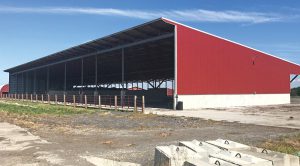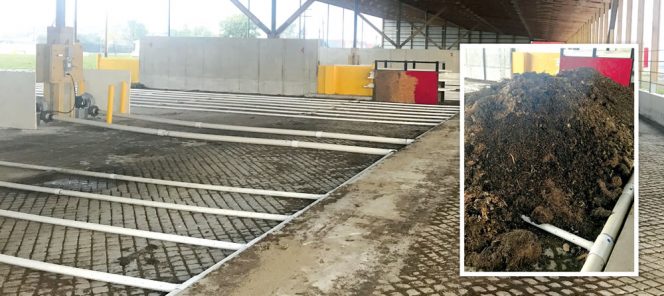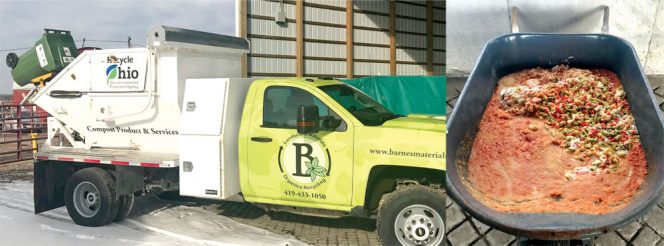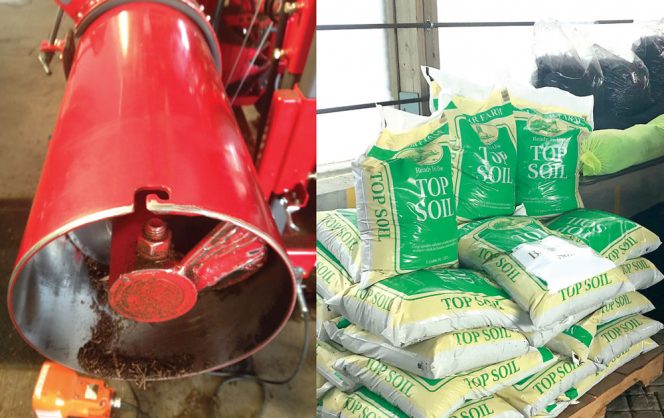Created via a unique public-private partnership, a converted cattle barn is being used to compost food waste from the prison and commercial generators.
Marsha W. Johnston
BioCycle May 2018

Converting a cattle barn at the Allen-Oakwood Correctional Institution (AOCI) that held 500 animals to accommodate composting was relatively inexpensive. Photo by Angel Arroyo-Rodriguez
The AOCI aerated static pile composting facility began taking commercial organics in November 2017, receiving food waste and yard trimmings from as far as 85 miles away. “After the dedication, it’s really starting to explode,” says Robert Nauman, AOCI business administrator and former farm manager, who received the ODRC Director’s Impact Award for his role spearheading the conversion of AOCI’s farm into a Compost Complex. “Our customer base is growing.”
Angel Arroyo-Rodriguez, Composting and Organics Recycling Program Leader for Ohio EPA is not surprised, noting that the state’s approximately 12 commercial composting facilities permitted to take food waste from outside sources cannot meet the demand to divert it. “We have a lot of generators looking for outlets to compost their organics,” explains Arroyo-Rodriguez. “It is difficult to estimate how many commercial facilities are needed to service just the state’s food processing industry. For example, southwest Ohio does not have a single facility.”
The AOCI Compost Complex in northwest Ohio can accept organics from any generator of material within its Class II permit. The correctional facility itself generates 2.5 tons/month of food waste — “a drop in the bucket” compared to the complex’s annual capacity of over 5,500 tons, says Nauman. In addition to feedstocks brought in from many miles away, the new facility receives yard trimmings and soybean meal, as well as manually depackaged food waste from a local cannery. In the future, he adds, it might take some horse manure, and has proposed a partnership with the Ohio Department of Transportation to compost road kill.

The retrofit required laying perforated piping on the floor, and installing fans and timers with a supporting electrical system. Food waste is composted with yard trimmings and soybean meal (inset). Photos by Angel Arroyo-Rodriguez
Cattle Barn Retrofit
Situated between two major Ohio watersheds — the Great Lake Erie Basin and St. Mary’s Lake, which continue to struggle with algae blooms — AOCI’s cattle barn was designed to meet state agriculture regulations for manure management, explains Nauman, “so the structure is self-contained for no runoff from manure when it housed cattle or, now, from composting.” All leachate drains into a swimming pool-sized, 10-inch-deep basin in the barn’s concrete floor.
Converting a barn that held 500 animals to accommodate composting was relatively inexpensive ($38,000). The retrofit required laying perforated piping on the floor, installing fans and timers with a supporting electrical system, and removing cattle equipment. Nauman notes that the fan system allows both positive and negative aeration to be used. “The majority of the time, we are using positive [aeration],” he says. “We use negative probably only in the first 12 to 14 hours if the product has a lot of moisture and an odor.” At that point, air is pulled from the piles through the pipes into a “homemade” biofilter — a 55-gallon lidded drum of water. The water is put back on the piles. The piles also can be capped with ground soybean stubble to help with odor control, which is paramount, he adds, as the facility has 2,000 inmates living 300 yards away.
The piles compost with aeration for 45 days, then are moved outside to cure for 3 to 4 months, after which material is tested. Best of all, Nauman adds, the Ohio winter has not been a factor. “Even today, we are at 7°F in Lima,” he told BioCycle in February, “and we are still cooking piles at 150°F.”

Barnes Nursery provides food waste collection and trucking of inbound waste streams and outbound finished product (left). AOCI diverts 2.5 tons/month of food waste (right) to the composting site. Photos by Angel Arroyo-Rodriguez
Meanwhile, ODRC facilitated permitting requirements and infrastructure modifications at AOCI, and provided offender and supervisor labor and an additional compost distribution channel through the Ohio Penal Industries (OPI). “With OPI involvement, we can sell the compost to other state agencies and departments,” says Nauman.

Barnes Nursery markets and distributes the compost. It utilizes a Rotochopper bagger (left) to fill bags of compost (right) and erosion control socks.
Reducing Recidivism
On the benefits side for partners, he adds, Barnes gets exposure to more potential compost customers among organizations that work with ODRC, an exclusive source of competitively priced bagged compost and erosion control socks (both filled with the Rotochopper bagger), and priority for hiring trained offenders upon their release. ODRC expects the new AOCI Complex to save approximately $30,000/year in food disposal costs, says Jacqueline Langhals, ODRC Energy Conservation & Sustainability Administrator, and provide 20 to 25 offenders with employable skills. Furthermore, the money that would be going towards hauling waste can now be invested back into the institution and ODRC’s primary mission of reducing recidivism, she adds.
It is the latter benefit that drove the project from the beginning, explains Nauman. To reduce recidivism among offenders, providing them a legitimate means of supporting themselves and their families is critical. While the farm at AOCI and other correctional facilities provided milk and meat, farm worker training provided little guarantee of a well-paying job on the outside. “We have learned through discussions with private composting organizations and other state agencies that there is a definite demand for experienced composting technicians,” she says. “And the demand for composting technicians is much higher than for farm workers.” Arroyo-Rodriguez notes that composting facilities have difficulty finding technicians, even at up to $15 an hour.
To further facilitate offender training in composting operations, ODRC plans to establish the new AOCI operation as an additional site for the Ohio State University’s compost operator certification course, which currently is offered only at its Wooster campus. The course certifies 20 to 30 individuals per year. “We hope to create that class for the offenders,” says Nauman, noting that OSU has a branch campus in Lima.
In the meantime, he has already begun work to expand ODRC composting operations to two more institutions, which will give ODRC the capacity to divert 25,000 tons of organic waste per year. (The figure is based on the size of the barns at those institutions that would be converted.) “It took us 363 days to get this one going, and I hope I can get these going more quickly,” he notes.
Nauman is clearly motivated in part by the AOCI Compost Complex workers who provided demonstrations to the public at the grand opening: “In 4 to 6 months, they had learned enough to talk to Ohio EPA guys about composting!”
Marsha W. Johnston is a Contributing Editor to BioCycle and an Editor at Earth Steward Associates in Arlington, Virginia.










